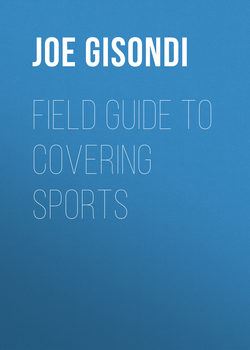Читать книгу Field Guide to Covering Sports - Joe Gisondi - Страница 41
На сайте Литреса книга снята с продажи.
Reporting Is Vital
ОглавлениеBefore writing a feature, figure out why you want to do it. Your editor is sure to ask you, and your readers are sure to wonder. What’s the news angle, the peg? In other words, why write it now?
For example, if you’re pitching a profile, why now? Did a player recently perform well, scoring 40 points or striking out 15 batters? Has a coach recently faced a personal challenge or been hired? Some stories are connected to news events—a coach gets hired or fired, a player gets injured or breaks a record, or players are tampering with bats in order to hit the ball farther and harder.
Sports Insider: On Finding Stories
The most important thing is finding good material. That sounds a little simplistic, but it’s true. What makes a good feature? Again, no easy answer. Sometimes it’s the person. Sometimes it’s the situation. And sometimes you’re surprised at what you find. Here’s a story: I had been around University of Miami football coach Randy Shannon as a player and an assistant for about 20 years. I didn’t know him well. But we’d talk occasionally. When he was named Miami’s coach, I heard a story from someone in the school that stunned me: Three of Shannon’s siblings had died of AIDS, his father had been murdered and another brother stole his identity. I asked him about this and, reluctantly at first, he talked. We talked some more. I talked with others. He saw I was serious and opened up some. He shared his vision of trying to help kids who came from the streets the way he had. It took several weeks in the summer of 2007, working between other stories. It was a tough feature to do because he was a very private person.
Dave Hyde, South Florida Sun-Sentinel
Perhaps the person you’re writing about is connected to an anniversary of an event (like the hockey gold medal game in the 1980 Olympic Games) or an amazing season (like the 1972 Dolphins, the first undefeated NFL team). Perhaps someone just died, so you are writing a more detailed obituary, one that runs days or weeks after the actual death. Or maybe you are writing a story on an issue, like composite bats, connected to a recent event such as when a softball pitcher was hit in the face with a line drive.
Features, especially the longer narratives, are all about rolling up your sleeves and doing some hard work. You can’t talk to only one or two people and get enough information to write a fully developed feature. And you can’t just sit down and offer your opinions for a column. Reporting is at the heart of any real journalism. Here are a few points to remember as you develop your stories.
Digital Assist: Tour Venues
Check out venues in your area, such as softball stadiums, basketball gymnasiums, Little League fields, fishing areas, or golf courses. The Boston Globe assembled a guide to New England’s minor league ballparks that blends photos, lists, and extended cutlines. You might even add audio with photos of nonathletes, such as a peanut vendor or an announcer on the public address system. Check out “Minor League Ballparks of New England” at www.boston.com/travel/explorene/specials/minors/parks_of_new_england/.
